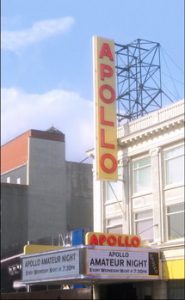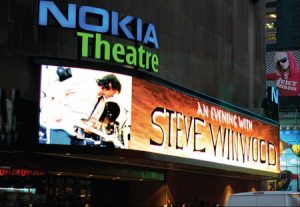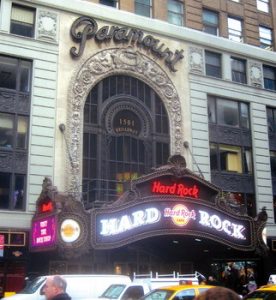LEDs + Lighting
Marquees: Windows to the Stage and Screen, Part 2
LED technology has updated The Apollo and Nokia theaters and the Paramount Building.
Published
17 years agoon
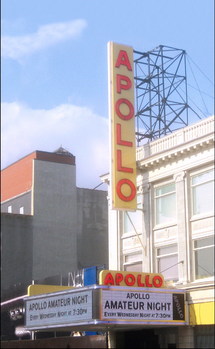
Apollo Theater Marquee Refurbishment
When an older theater being refurbished has a landmark distinction, it becomes a double bind of two conflicting viewpoints. On one hand, the building calls for modernization to address an increasingly competitive entertainment marketplace. On the other hand, it must conform to the landmark commission’s regulatory guidelines about its original look.
Faced with these guidelines, New York City’s Apollo Theater in Harlem recently embarked on a multimillion-dollar refurbishment that included its façade and, most visibly, its original marquee readerboard.
The 900-seat Apollo Theater was originally built in 1914. Its musical heritage forms the cornerstone for much of American jazz, rhythm and blues, comedy and soul music. Over the decades, the iconic tourist destination has featured such world-class performers as Bill “Bojangles” Robinson, Bessie Smith, Ethel Waters and Duke Ellington. More recently, Whoopi Goldberg and Bill Cosby have appeared on the Apollo’s stage. The theater’s brand and heritage have earned it a state and national landmark status. Such “image protection” challenges proposed changes that may affect the revised design.
The Apollo Theater organization commissioned Rule7Media LLC (New York City), a company that blends cultural communications and technology applications to develop new avenues of brand development. Rule7Media’s mission was to reconceptualize and execute a new design for the marquee, and also to plan the marquee’s content creation to promote the Apollo’s ongoing shows.
Advertisement“Our sign strategy included not only a new electronic marquee,” Rule7Media President Rik Willard said, “but also installing and operating a series of nine, street-level plasma screens to promote the theater’s current and new shows.”
Rule7Media installed an LED message center that replicates the 1940s plastic-letter-based marquee it replaced. The full-color, 12mm- pitch eVidia LED display, from MultiMedia Electronic Displays (Rancho Cordova, CA), presents three, discreet faces. The largest, 24 ft. 3 4 ft. 8-in. side fronts street traffic, and each of the two side faces measures 17 ft. 4 in. 3 4 ft. 8 in.
Emulating the marquee’s original look (a white, backlit sign face with plastic letters and horizontal gridlines) precluded the use of graphics and colors. However, Rule7Media installed the nine plasma screens in the lobby and vestibule to “provide a more realtime presence of communicating the Apollo Theater’s entertainment programming to the public,” Willard said. “It’s much brighter and can be seen by more people from further away.”
Also, the electronic marquee no longer requires a staff member to approach it with a ladder and a bucket of plastic letters.
Willard said the community appreciated the changes and the “inherent visual possibilities. Through the use of LED technology, we hope that the community [and the Landmark Commission] will ultimately realize the full potential [color and animation] of how the marquee can be used to increase the theater’s ticket sales and how the improved look provides more of a quality viewing experience for potential customers.”
Apollo Theater’s Marquee Landmark Preservation Process
AdvertisementMost major U.S. cities have adopted landmark commissions that establish and maintain various landmark laws that help preserve the aesthetically and historically important buildings that comprise a city’s heritage. These landmark organizations decide which properties should be granted landmark status and then enact and enforce regulations to protect these properties’ aesthetic and historic natures.
In most cases, this process involves local, state and federal organizations, and, once a marquee changeover plan is established, the theater operator and sign integrator can expect years of proposals, presentations and meetings before an electronic marquee can be expected to be added to their facade.
Rik Willard, the Apollo Theater’s senior sign consultant, signagesystems integrator and content creator, said the marquee’s transformation required 2½ years between its original concept and the construction of the actual LED display. During that time, Willard dealt with many organizations, including:
New York State Landmarks Commission. Willard explained to them why and how electronic signage could modernize the theater’s appearance.
State Dept. of Parks, Recreation and Historical Preservation and the New York Empowerment Zone. These organizations issued public fund refurbishment grants to the Apollo Theater. Willard reassured them the improved electronic marquee met proper Landmark Commission concerns.
Time Warner’s audiovisual team. The private-fund financial partners with the refurbishment project provided technical assistance to educate the Landmark Commission.
AdvertisementLocal community boards. Having reviewed the theater and marquee redesign plan, they ensured the project fit in with the surrounding cityscape and the Business Improvement District (BID).
Nokia Theater
The Nokia Theater proves the ultimate value of a prime location. Flaunting the largest theater marquee in New York City doesn’t hurt, either.
The theater is operated by AEG LIVE, which owns several concert venues throughout the United States and the world, including the Colosseum at Caesars Palace (see ST, May 2003, page 70). The 2,100- capacity theater in the heart of Times Square (47th St. and Broadway) maintains a full-color, 1,344 3 144-pixel-resolution, 10mm-pitch Mitsubishi LEDerAd LED screen. Manufactured by Mitsubishi Diamond Vision (Lawrenceville, GA), the 85-ft.-long screen stretches along roughly a fifth of the length of 47th St.
A $21 million refurbishment recast the Nokia Theater, which was originally a movie theater, into a multipurpose concert hall that hosts live music concerts, web broadcasts, award shows and special events. Bon Jovi, Jay-Z, Rod Stewart, Gregg Allman, Skynyrd and Tom Jones recently performed here.
The marquee is managed by Arcadia New Media Services, a New York City-based company that specializes in video production, web design, DVD authoring and related, new-media production services.
Arcadia co-founder Daniel Salimbene said, “Our primary job with Nokia Theater is to present the Nokia marquee as a motivator to selling tickets to its upcoming shows. Times Square is a very media-rich environment, and we intensely compete for everyone’s attention as they walk past our marquee. We do that by putting visual glitz on the screen. This gets a lot of passersby attention long enough for them to see what’s happening now and with succeeding shows coming to the Nokia Theater.”
Arcadia designs the main message on the center screen, which promotes the latest act, and the two side screens, which promote other forthcoming theater events. Thus, the marquee sells three shows simultaneously.
“For us, a marquee-design challenge is keeping the design style ‘true’ for each act,” said Jan Eckhard, Arcadia’s other co-founder.
Typical bookings during a week could include country music on Monday, heavy metal on Tuesday and, the next evening, a corporate event. Graphic promotions must be uniquely suited to each audience.
“There’s nothing more dramatic for fans than approaching the Nokia Theater on the night of an event and seeing their favorite band’s video clips going across our 85-ft. marquee display. Doing this gets our audience excited even before they enter the theater,” Eckhard said.
The marquee promotes programs until opening night. “Sold Out” marquee postings remind the public of the theater’s popularity, and upcoming shows are also promoted.
The Nokia screen also makes passersby stars. Having possessed the theater’s naming rights, Nokia uses the marquee to demonstrate the Nokia mobile phone’s camera functions. Nokia staff roam Times Square to photograph people and transmit them to the Nokia Theater control room, where the images are uploaded and flashed on the screen.
The most innovative use of the Nokia marquee is its real-time mode. During a performance, a live camera captures the stage action and redirects it to the main marquee screen, where the public can peek at the ongoing stage action. Rod Stewart’s show has been highlighted on the marquee, and other performances are currently being considered.
Paramount Building
New York City, which has very stringent, landmark-preservation regulations, was first involved in a marquee-protection project when the Paramount Building (Broadway & 42nd St.) marquee was transformed into an electronic display. Originally built in 1926, the building housed Paramount Pictures offices and, at its base, a 3,600-seat movie palace (built by Rapp & Rapp).
On the theater’s front facade, the fabulous Marquee and Arch proclaimed its silver-screen wonders to the world. At various times, the theater introduced Gary Cooper, William Powell, Mae West and Fred Astaire to a city eager to see them on the cinema screen. By 1964, the last film reel had spun through its projection booth, and the theater and the Paramount closed.
In 2000, World Wrestling Entertainment (WWE) began construction of an entertainment complex. The interior theater space was transformed into a restaurant, retail store and nightclub, for more than $38 million. The Paramount Building’s famed Marquee and Arch was restored to its original grandeur. A full-color LED videoscreen, manufactured by Multimedia LED (Rancho Cordova, CA) was installed in the front and side display areas of the marquee framework.
To maintain the original design’s architectural intent, the marquee’s outer facade couldn’t be altered. The interior space was hollowed out to accept the LED sign cabinet, which was carefully inserted into the marquee structure. In 2005, the WWE was replaced with the Hard Rock Cafe, Times Square. The new tenant inherited the marquee and currently operates it as a message center.
All the world’s a stage
Rule7Media’s Willard described marquees as “underused entertainment real estate whose potential as an animated display system for theaters is unlimited.” He says people process information on the go and are more visually literate. Over time, he sees more theater operators upgrading their current marquees so that they become a 21st-century branding tool and a carnie barker for the theater.
Louis M. Brill is a journalist and consultant for high-tech entertainment and media communications. He can be reached at (415) 664- 0694 or louisbrill@sbcglobal.net
SPONSORED VIDEO
Who’s Steering Signs of the Times?
We dive into the history of the sign industry’s oldest trade journal, highlighting some interesting facts about how it all started to where it’s headed. Did you know that Signs of the Times is nearly 120 years old?
You may like
Advertisement
Subscribe

Magazine
Get the most important news
and business ideas from Signsofthetimes Magazine.
Advertisement
Most Popular
-

 Tip Sheet2 weeks ago
Tip Sheet2 weeks agoSign Tips for Construction Fence Graphics and CNC Tables
-

 Real Deal2 weeks ago
Real Deal2 weeks agoA Wrap Shop Plots to Take Back a Poached Installer
-

 Paula Fargo3 days ago
Paula Fargo3 days agoSelling Your Sign Company Via the Franchising World
-

 Photo Gallery21 hours ago
Photo Gallery21 hours ago21 Highlights from the American Sign Museum Main Street Expansion
-
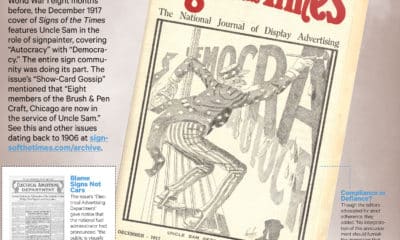
 Signs of the Times4 days ago
Signs of the Times4 days agoDecember 1917 Signs of the Times Cover: Safe for Democracy
-

 News1 week ago
News1 week agoMUTOH Introduces New Single-Pass ADA Features
-

 Special Report1 week ago
Special Report1 week agoThe Wide World of Non-English Signs
-

 News2 weeks ago
News2 weeks agoWells Fargo Sign Removed From Jacksonville Tower

